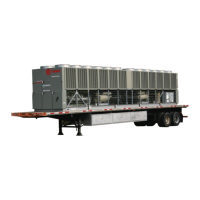61 RTAC-SVX002A-EN
VI-Controls Interface
CH530 Communications Overview
The Trane CH530 control system that
runs the chiller consists of several
elements:
• The main processor collects
data, status, and diagnostic information
and communicates commands to the
starter module and the LLID (for Low
Level Intelligent Device) bus. The
main processor has an integral display
(DynaView).
• Higher level modules (e.g.
starter) exist only as necessary to
support system level control and
communications. The starter module
provides control of the starter when
starting, running, and stopping the
chiller motor. It also processes its own
diagnostics and provides motor and
compressor protection.
• Low level intelligent device
(LLID) bus. The main processor
communicates to each input and output
device (e.g. temperature and pressure
sensors, low voltage binary inputs,
analog input/output) all connected
to a four-wire bus, rather than the
conventional control architecture of
signal wires for each device.
• The communication interface to
a building automation system (BAS).
• A service tool to provide all
service/maintenance capabilities.
Main processor and service tool
(TechView) software is downloadable
from www.Trane.com. The process is
discussed later in this section under
TechView Interface.
DynaView provides bus management.
It has the task of restarting the link, or
lling in for what it sees as “missing”
devices when normal communications
has been degraded. Use of TechView
may be required.
The CH530 uses the IPC3 protocol
based on RS485 signal technology
and communicating at 19.2 Kbaud to
allow 3 rounds of data per second on
a 64-device network. A typical four
compressor RTAC will have around 50
devices.
Most diagnostics are handled by the
DynaView. If a temperature or pressure
is reported out of range by a LLID, the
DynaView processes this information
and calls out the diagnostic. The
individual LLIDs are not responsible
for any diagnostic functions. The only
exception to this is the Starter module.
NOTE: It is imperative that the CH530
Service Tool (TechView) be used to
facilitate the replacement of any LLID
or recongure any chiller component.
TechView is discussed later in this
section.
Controls Interface
Each chiller is equipped with a
DynaView interface. The DynaView
has the capability to display information
to the operator including the ability
to adjust settings. Multiple screens
are available and text is presented in
multiple languages as factory-ordered
or can be easily downloaded from www.
trane.com.
TechView can be connected to either
the DynaView module and provides
further data, adjustment capabilities,
diagnostics information using
downloadable software.
DynaView Interface
The DynaView share the same
enclosure design: weatherproof and
durable plastic for use as a stand-alone
device on the outside of the unit or
mounted nearby.
The display on DynaView is a 1/4 VGA
display with a resistive touch screen
and an LED backlight. The display area
is approximately 4 inches wide by 3
inches high (102mm x 60mm).

